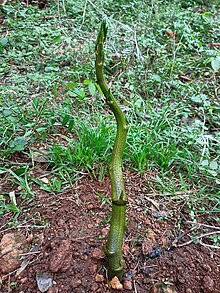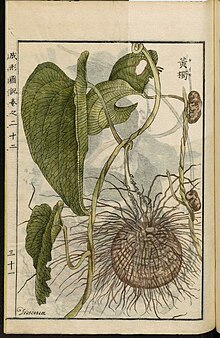ニガカシュウ
| ニガカシュウ | |||||||||||||||||||||
|---|---|---|---|---|---|---|---|---|---|---|---|---|---|---|---|---|---|---|---|---|---|

| |||||||||||||||||||||
| 分類 | |||||||||||||||||||||
| |||||||||||||||||||||
| 学名 | |||||||||||||||||||||
| Dioscorea bulbifera L.[1] | |||||||||||||||||||||
| シノニム | |||||||||||||||||||||
|
ニガカシュウ (Dioscorea bulbifera) は、ヤマノイモ科のヤムである。英語では、air potato、air yam、bitter yam、cheeky yam、potato yam[2]、aerial yam[3]、parsnip yam[4]等と呼ばれる。アフリカ、アジア、オーストラリア北部が原産であるが[1]、ラテンアメリカ、インド西部、アメリカ合衆国南東部、様々な島嶼部等、多くの地域で栽培され、帰化している[1]。球根よりも肉芽(むかご)を目的に栽培されるため、ナイジェリア・ピジンでは、up-yamと呼ばれる[5]。
記載
[編集]


ニガカシュウは多年生つる植物で、幅広の互生葉を持ち、2種類の貯蔵組織を持つ。1つは巻き付く茎の葉腋に形成される肉芽で、もう1つは地下の球根である。球根は、小型で縦長のジャガイモに似ている。いくつかの品種では食べることができ、特に西アフリカでは食用に栽培される。食用品種の球根はしばしば苦味を持つが、茹でることで苦味を除くことができる。その後は他のヤムやジャガイモ、サツマイモと同様に調理する。
「苦何首烏(にがかしゅう)」の和名は、塊根が生薬の何首烏(ツルドクダミ)に似ていることからついたが、日本に自生しているものは食用、薬用とも顧みられない雑草である。
ニガカシュウは非常に早く生育し、1日辺り約8インチも伸び、最終的には60フィート以上に達する[6]。通常、木の頂端まで達し、自生する植物を乗っ取ることもある。肉芽から更に新しい個体が発生し、肉芽は植物の分散の手段を果たしている。茎は冬には枯れるが、肉芽及び球根から再発芽する。生殖と分散の主な手段は肉芽である。肉芽は非常に小さい段階で発芽する能力があるため、ニガカシュウの制御を困難にする。つるには小さく白い花が付くが、フロリダ州では見られることは稀である。果実は蒴果である[7]。
利用
[編集]ニガカシュウは、結膜炎、下痢、赤痢やその他の病気の治療のための伝統医学に用いられる[8]。
オーストラリアのティウィ人にとっては特に重要で、kulamaと呼ばれる重要な儀式に用いられる。儀式の間、球根を儀式的に調理し、3日目にこれを食べる[9]。
毒性
[編集]フロリダ州で自生しているもののような栽培種以外の種は、毒を含むことがあり、ホルモン避妊で用いられるもの等の様々な合成ステロイドホルモンの主原料となるステロイドのジオスゲニン等が含まれる[2]。このような野生種でも、乾燥したり茹でると食べられると言われることがあるが[10]、実際の毒性についてはよく分かっていない。
外来種
[編集]フロリダ州等のいくつかの場所では、成長が早く、葉が大きく、つるが頑強に広がることにより、その下に生育する植物の日陰となるため、有害な雑草とみなされている。つるの肉芽から芽が出て新しいつるとなり、互いに絡み合って厚いマットを形成する。植物の地上部分が刈られても、地下の球根は生き延び、後に新しい芽を出す[11]。
ニガカシュウを餌とするハムシの一種Lilioceris cheniは、生物的防除としての用途が研究されている[12][13]。
出典
[編集]- ^ a b c d "Dioscorea bulbifera". World Checklist of Selected Plant Families (WCSP). Royal Botanic Gardens, Kew. 2017年3月17日閲覧。
- ^ a b “Meet the plants: Dioscorea bulbifera”. National Tropical Botanical Garden. 2016年1月16日時点のオリジナルよりアーカイブ。2007年11月17日閲覧。
- ^ "Dioscorea bulbifera". Germplasm Resources Information Network (GRIN). Agricultural Research Service (ARS), United States Department of Agriculture (USDA). 2022年2月22日閲覧。
- ^ “Dioscorea bulbifera var. elongata (F.M.Bailey) Prain & Burkill: Parsnip Yam”. Atlas of Living Australia. 6 January 2020閲覧。
- ^ Blench, Roger (2006). Archaeology, language, and the African past. Altamira Press. ISBN 9780759104655
- ^ Invasives Database, TexasInvasives.org, Dioscorea bulbifera
- ^ Flora of North America, Dioscorea bulbifera Linnaeus, Sp. Pl. 2: 1033. 1753.
- ^ Duke, J. A.; Judith L. DuCellier (1993). Handbook of Alternative Cash Crops. CRC Press. ISBN 978-0-8493-3620-1
- ^ Pieroni, Andrea (2005). Prance, Ghillean; Nesbitt, Mark. eds. The Cultural History of Plants. Routledge. p. 36. ISBN 0415927463
- ^ “Pest Plants, Air Potato: Dioscorea bulbifera”. WalterReeves.com (Jan 2010). 2006年11月12日時点のオリジナルよりアーカイブ。2010年1月29日閲覧。
- ^ “Air potato takes over”. The Nature Conservancy. May 15, 2007時点のオリジナルよりアーカイブ。February 10, 2013閲覧。
- ^ Field release of Lilioceris cheni Gressit & Kimoto (Coleoptera: Chrysomelidae) for biological control of air potato, Dioscorea bulbifera (Dioscoreaceae), in the continental United States: Environmental Assessment. USDA. 2011.
- ^ Morgan, C. In South Florida, a tiny new weapon against the invasive potato vine. Miami Herald September 21, 2012. Archived October 5, 2012, at the Wayback Machine.
関連文献
[編集]- Van Wyk, Ben-Erik (2005). Food Plants of the World. Portland, Oregon: Timber Press, Inc. ISBN 0-88192-743-0
- Dioscorea bulbifera. Archived 2012-01-24 at the Wayback Machine. University of Florida.
外部リンク
[編集]- Species Profile - Air Potato (Dioscorea bulbifera), National Invasive Species Information Center, United States National Agricultural Library. Lists general information and resources for Air Potato.
Text is available under the CC BY-SA 4.0 license; additional terms may apply.
Images, videos and audio are available under their respective licenses.
